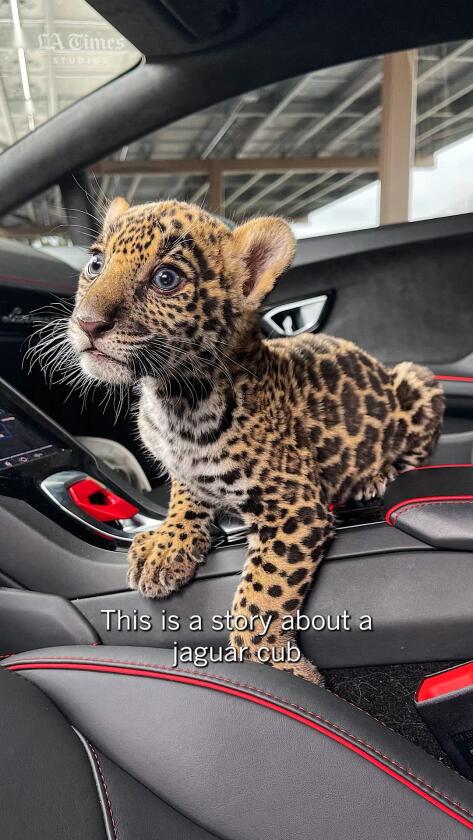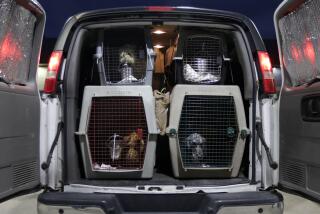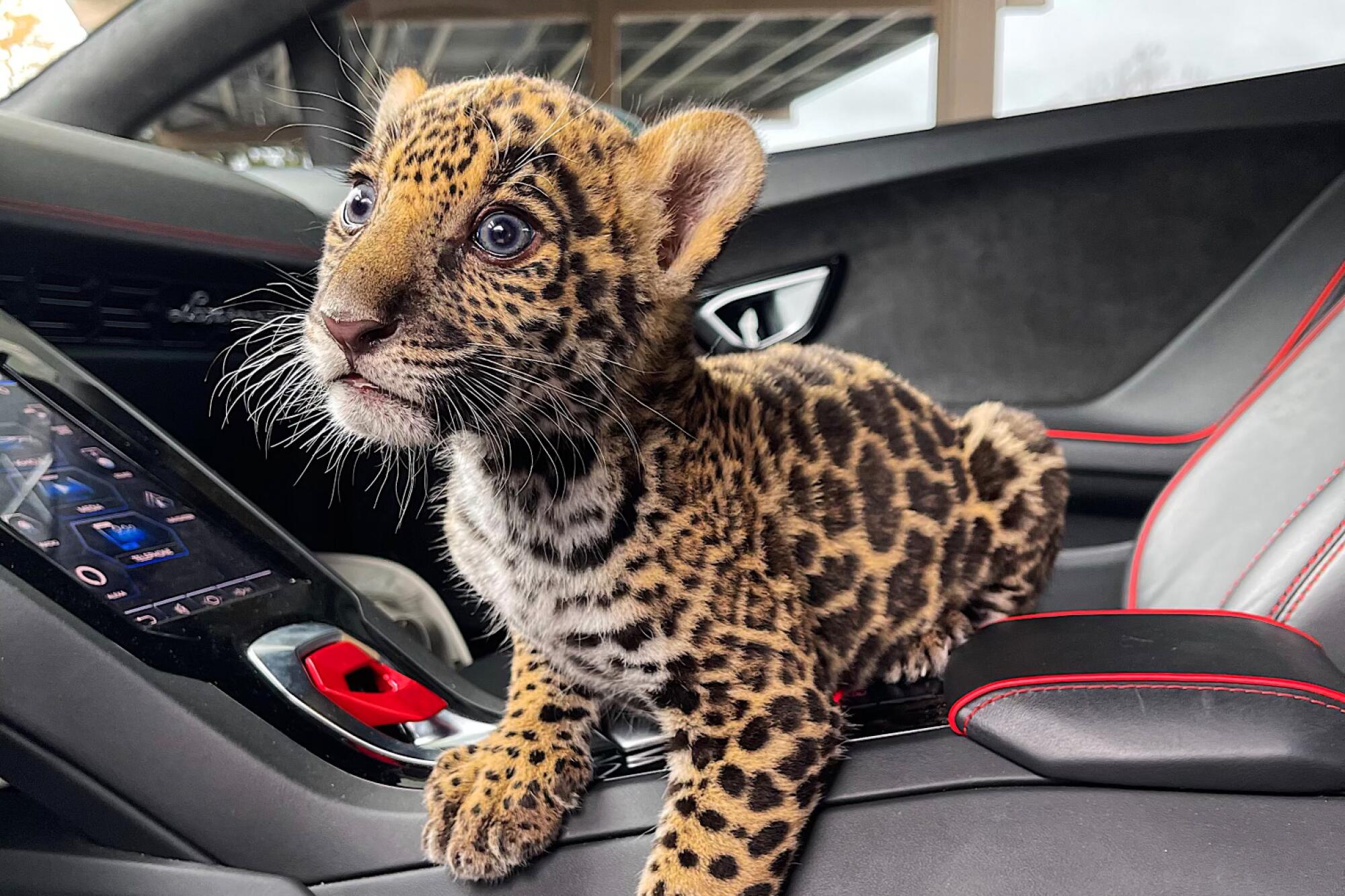
At less than a month old, unsteady on his small paws, the jaguar cub was already working.
While others born in the Amazon rainforest were still being nursed by their mothers, he was rented out to do a photo op in a Texas hotel room for $1,000 an hour.
People snapped their fingers to get the cub’s attention and held him on their laps. They posed with him for photos later posted on Instagram.
In video of one such photo shoot, the cub — smaller than a house cat — shrank back from the loud voices around him. As the jaguar wandered on the hotel carpet, Abdul “Mannie” Rahman, who had paid to rent him, decided he wanted to purchase the tiny feline.
Abdul “Mannie” Rahman bottle-feeds the jaguar cub a milk mixture.
Rahman, who made his money illegally selling marijuana, paid a discounted rate of $25,000 and another $1,000 to have the cub transported from Texas to his California home — breaking federal law.
“All I knew was the jaguar was cute, and I had the money, and I wanted it,” Rahman, now 36, told The Times.
The love affair did not last long. Investigators say the jaguar was sold from one drug dealer to another. Six months after he was born, the cub was dumped at a San Diego sanctuary, malnourished, patches of fur missing, covered in feces.
The ensuing investigation would ensnare a Texas woman notorious for dealing in exotic animals (and posing naked with them on her OnlyFans account), result in federal charges and eventually lead to the rescue of yet another jaguar.
It would also provide a window into the exotic pet trade and the ill-fated animals caught up in it.
A jaguar cub changed hands several times, used as a prop on social media and OnlyFans, before finally being left at an animal sanctuary in San Diego. Now, the sanctuary is trying to ensure it has enough resources to provide a permanent home for the cub.
‘Tiger mom’
The fuzzy cub, eyes half-closed and claws outstretched, appeared on Instagram at 14 days old.
Trisha Meyer, who refers to herself as a “Texas Zookeeper,” posted a gallery of photos and videos, holding the jaguar in the palm of her hand, squeezing him to her cheek. In one 2021 video, as the cub lay on Meyer’s lap, he licked at the empty air.
“thankful to be his momma,” Meyer wrote about the cub, whom she called Amador. “#catmom”.
Meyer, now 42, made a living selling exotic animals from her home in Texas, where the laws on exotic pet ownership are liberal and business is brisk. She posted pictures of macaws, monkeys, tigers and foxes.
On Meyer’s OnlyFans page, the posts were less PG. She sandwiched Amador between her exposed breasts. “Message me for video special request,” she wrote.
It’s unclear how Amador wound up in Meyer’s care, but by then she had a long and checkered history with animals, both exotic and domestic.
A California resident had gone to authorities in the fall of 2016, alleging that he had paid Meyer $3,000 for a Savannah kitten, whose spotted coat resembles that of a wild cat. The buyer never received the cat, according to a criminal complaint filed in Texas.
When authorities caught up with Meyer in Pahrump, Nev., in November 2016 to arrest her on a felony warrant out of Texas, they spotted three tigers loose in the backyard of the house where she was staying, according to police dispatch records.
Meyer also was charged with child endangerment in Texas. A game warden said he’d gone to Meyer’s Houston home in September 2016 and observed three tiger cubs and a skunk roaming the house, according to the criminal complaint. The game warden said Meyer’s 14-year-old daughter was petting and making physical contact with the cubs.
As a condition of her bond, Meyer could not possess or sell exotic animals. She pleaded guilty in 2017 to a theft charge tied to the Savannah kitten sale and received two years’ probation. She paid restitution, and the child endangerment charge was dismissed, according to the Harris County district attorney’s office.
In a TV interview broadcast after Meyer’s guilty plea, her lawyer said she could possess exotic animals as long as she complied with the law. She added that Child Protective Services in Nevada did an investigation and cleared Meyer there.
“My child was never in danger, none of my four children have ever been in danger,” Meyer told the reporter during the interview with her attorney. “Nobody’s been hurt by our animals.”
Meyer referred to her children as “young zookeepers.” She said teachers at their schools started referring to Meyer as the “tiger mom.”
“She’s going to comply with the law to a T,” her attorney, Penny Wymyczak-White, said.

But then came more allegations.
In 2019, an Arkansas resident accused Meyer of selling her a lethargic and sickly Savannah kitten for $4,500, according to a Texas criminal complaint. The cat soon died. A necropsy showed emaciation was a contributing factor.
That same complaint alleged Meyer had sold a Las Vegas resident five Savannah kittens for more than $16,000. After one of the cats was diagnosed with an infectious disease, all had to be euthanized, according to the complaint.
In 2020, a Nevada resident said she had agreed to purchase a Bengal kitten from Meyer for $6,500, according to another criminal complaint. After the buyer opened the bag that held the kitten, which was thrashing violently and hissing, the animal attacked her, drawing blood. She told police she later learned that Meyer sold her a Geoffroy’s cat — a wild species — not a Bengal, an exotic-looking domesticated breed.
According to the complaint, Meyer agreed to take back the cat but blocked the buyer on social media and changed her phone number without returning the $6,500.
On April 17, 2021, as Meyer’s cases wound their way through the Harris County court system, the “tiger mom” took the jaguar cub to a Hyatt Regency hotel room in Austin for his hour-long photo session.
Once there, investigators say, she sold him.
California living
Neighbors had no clue a jaguar cub was living in their Riverside County neighborhood.
After arriving in Southern California in May 2021, Amador got a new name: Hades.
It wasn’t Rahman’s first time owning an exotic animal. The year before, he said, he had purchased a marmoset from Meyer that was not a baby as he’d been led to believe. After the monkey bit him, he said, he left the primate in a Las Vegas pet shop for a friend of Meyer’s to pick up.
Rahman asked for his money back. Instead, Meyer offered him a $5,000 credit, which Rahman used to buy the jaguar.
“I’m an animal person. I love animals, especially wild ones,” Rahman told The Times. “When I’m getting offered to buy a wild animal, and it’s so cute when you see it, when it’s small, who the f— is gonna say no? No one will.”
Rahman kept the jaguar in his five-bedroom house in Murrieta. After photos were posted online, investigators said, Meyer texted Rahman and warned him to “get a handle on that.”
“If I got word of it here. That means others are seeing that & will snitch and they will be trying to track him down,” she wrote, according to a California criminal complaint. Meyer could own a jaguar in Texas, but she was not allowed to sell an endangered species out of state. It’s also illegal to own a jaguar in California.
Before long, according to federal fish and wildlife investigators, Rahman found it difficult to care for the jaguar and sold him — for around $20,000.
Soon the cub showed up again in Instagram videos, which were traced back to a home in Riverside County.

When Bobbi Brink — founder and director of the Lions Tigers & Bears Sanctuary in San Diego County — learned of the videos circulating online, she alerted Austin Smith, a warden with the California Department of Fish and Wildlife who conducted annual compliance inspections at her facility.
“All we knew at that point was that there was a jaguar in Riverside,” Smith said.
As Smith prepared to investigate, an attorney called the sanctuary to ask if a client who had a jaguar could leave the animal at the facility. Brink said she could not take the jaguar without letting Fish and Wildlife know. She also didn’t have a habitat available.
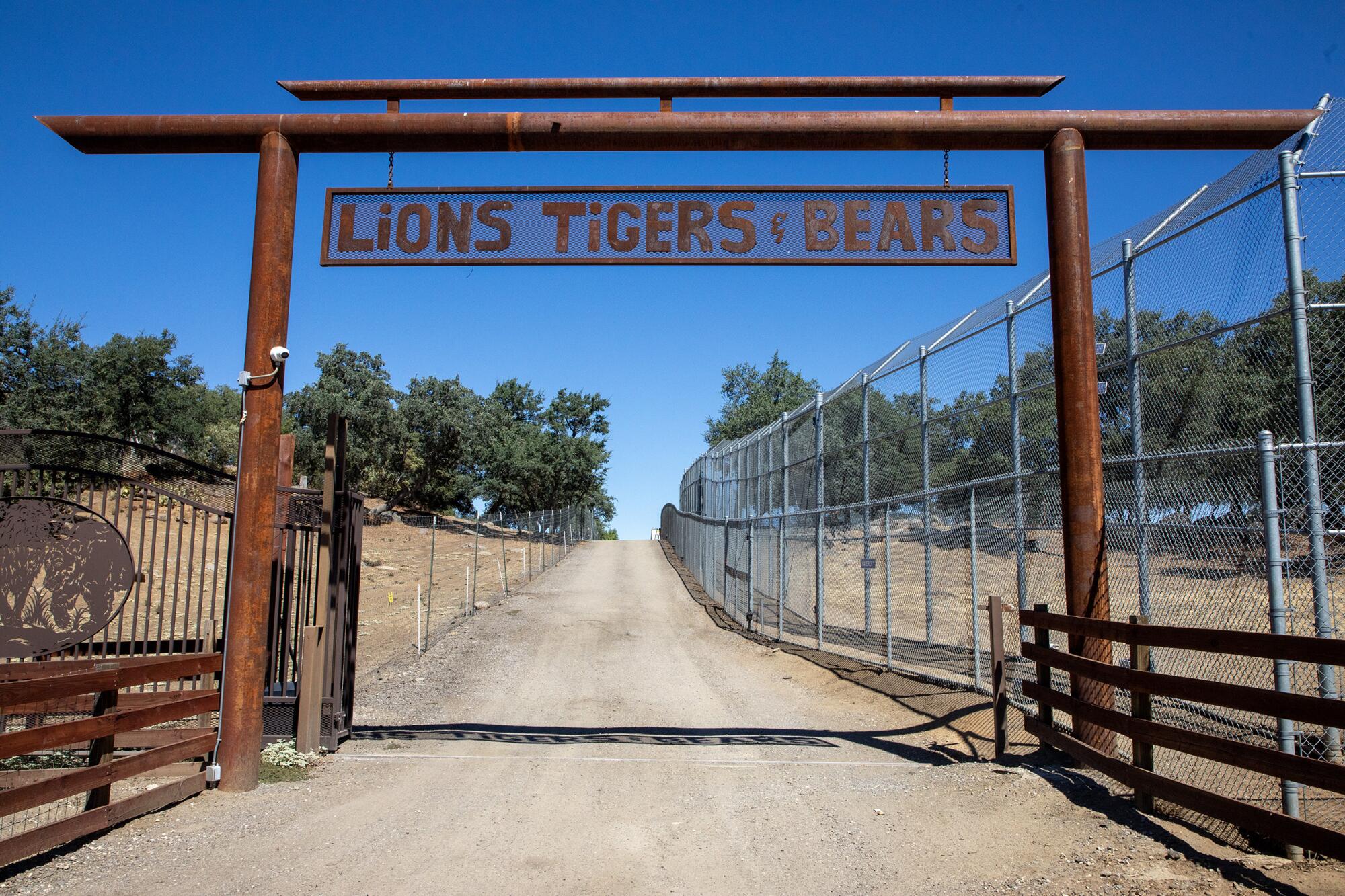
On Sept. 17, 2021, the sanctuary’s surveillance system captured video of a man pulling up at the front gate about 10 p.m. in a Mitsubishi Outlander and abandoning a large dog kennel.
When they found the jaguar the next morning, Brink recalled, he was shaking and urinating in fear.
They named the cub after the construction worker who first spotted him: Eddie.
A jaguar fingerprint
The case of the abandoned jaguar was the last one Ed Newcomer worked before he retired.
In his more than 20 years as a special agent for the U.S. Fish and Wildlife Service, Newcomer had brought down a notorious butterfly trafficker and gone after a caviar trafficking operation involving Russian mobsters. His investigations touched on every continent, including Antarctica.
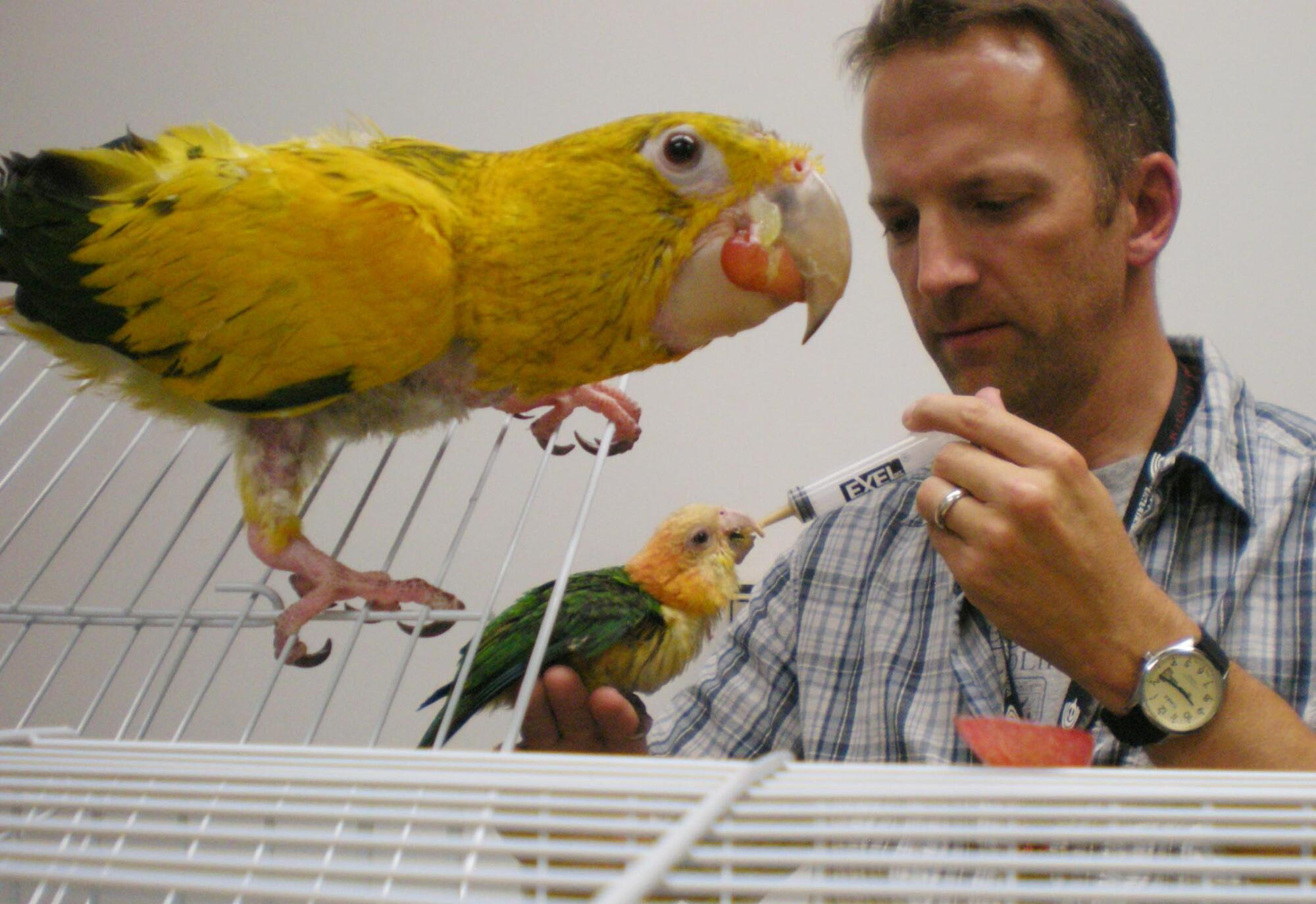
While big cat trafficking is rare, Newcomer said, he had experience looking into the exotic pet trade. He recalled a home filled with containers, each one with a snake crammed inside. The reptiles never saw the sun.
“When you arrest these people, and they end up in front of a judge, they tell the judge, ‘I’m an animal lover. I just got a little carried away.’ And nothing pisses me off more. They are not animal lovers,” Newcomer said. “They are either in it for the money or they’re in it for the obsession of collecting and owning and having and controlling.”
Smith and Newcomer teamed up on Eddie’s case.
Newcomer sent social media photos and videos of the cub to Mathias Tobler, director of population sustainability at the San Diego Zoo Wildlife Alliance, and asked him to confirm they were of the same jaguar abandoned at the sanctuary.
One showed a man — identified in a criminal complaint as A.G. — who posted videos of the cub at a home on Lakepointe Drive in Riverside. In another, an aspiring influencer identified as O.B. posed with the jaguar, with an expensive car in the background.
Tobler utilizes spot comparisons for population monitoring of jaguars in Peru. He likened the animal’s unique spot patterns to a fingerprint that allowed him to confirm Eddie was the same cat appearing on Instagram.
“It’s pretty horrific to see that and to know that that happens,” Tobler said. “People treating him like a little pet cat and passing him around for entertainment.”

A.G. owned the home on Lakepointe Drive but denied knowing anything about a jaguar. In order to shake something loose, the investigators served search warrants on Instagram, canvassed A.G.’s workplace and neighborhood and subpoenaed records from A.G.’s family business.
Eventually the investigators learned the cub belonged to someone who rented the home from A.G. — Hector Gomez, who had warrants out for his arrest in Texas and Arizona for allegedly selling narcotics to an undercover officer and trafficking marijuana via an Amtrak train between California and Texas, according to Smith.
Newcomer and Smith monitored Gomez’s home using a camera a neighbor allowed them to place on their back fence. After spotting a moving van in the driveway in March 2022, authorities — including Newcomer — made their move, arresting Gomez on the outstanding warrants.
According to a witness interviewed by Newcomer and Smith, Gomez planned to kill the jaguar after it grew too big.
O.B. eventually told Newcomer that the woman who had sold Rahman the cub in Texas was blond and wore a lot of makeup. Newcomer called up a fellow federal agent who worked in the Lone Star State.
“‘Instantly he said, ‘That’s Trish Meyer, we have been after her for years. She is notorious,’” Newcomer recalled. “That’s the first time I heard Trish Meyer’s name.”
As part of her release on bond in the Texas cases, Meyer agreed that she wouldn’t have contact with any animals — “unless at an accredited zoo or wildlife park” — aside from domesticated dogs and cats, monkeys weighing less than 20 pounds and birds that were legal to possess.
But Meyer filed a report with the Houston Police Department in 2022, informing them that someone had stolen a U-Haul van with several animals that belonged to her, according to a motion to revoke her bond. Among the animals she listed inside: 23 dogs, six cats, two geese, two South American armadillos and a coatimundi.
When authorities recovered the van, the prosecutor wrote, they found animals in crowded cages stacked atop each other and in some cases barely able to move around. Few had access to food or water. During medical evaluations, a bulldog puppy was found with an anal prolapse and necrotic tissue, several dogs had upper respiratory infections and several dogs and cats had intestinal parasites, the prosecutor wrote.
A federal grand jury indicted Meyer in October 2022 for the sale of the jaguar cub. She was a fugitive for more than a month before she turned herself in. Meyer was charged with interstate transportation of an endangered species in the course of commercial activity, interstate sale of an endangered species, trafficking prohibited wildlife species and trafficking endangered species. Rahman was also charged.
In December 2022, a federal law was enacted to end the private ownership of big cats. The Big Cat Public Safety Act prevents unlicensed people from possessing, breeding and transporting the animals. It also prohibits licensed exhibitors from allowing the public to make contact with the animals, including cubs.
Rahman was sentenced in July 2023 to a year of probation and was ordered to pay $30,000 in restitution to the sanctuary. Meyer pleaded guilty in June 2023 to trafficking endangered species and is set to be sentenced in November. She could face up to five years in prison.
“I truly believe everything happens for a reason & now even BIGGER opportunities have been opened up to me,” Meyer posted in July 2023 on her Instagram account, alongside a news article calling her the new “Tiger King” — a reference to the well-watched docuseries on Netflix about the subculture of exotic animal breeders and traffickers.
“I have the utmost respect for everyone on my case and at the end of the day we all love animals and are in it to protect them.”
Meyer did not respond to requests from The Times for comment.
As part of a continued investigation stemming from Eddie’s case, authorities last year arrested a Texas couple on suspicion of selling protected wildlife in the first case filed under the Big Cat Act. Rafael Gutierrez-Galvan admitted to selling a margay— another wild cat — for $7,500 and later selling a jaguar cub. Federal agents recovered both animals.
A forever home
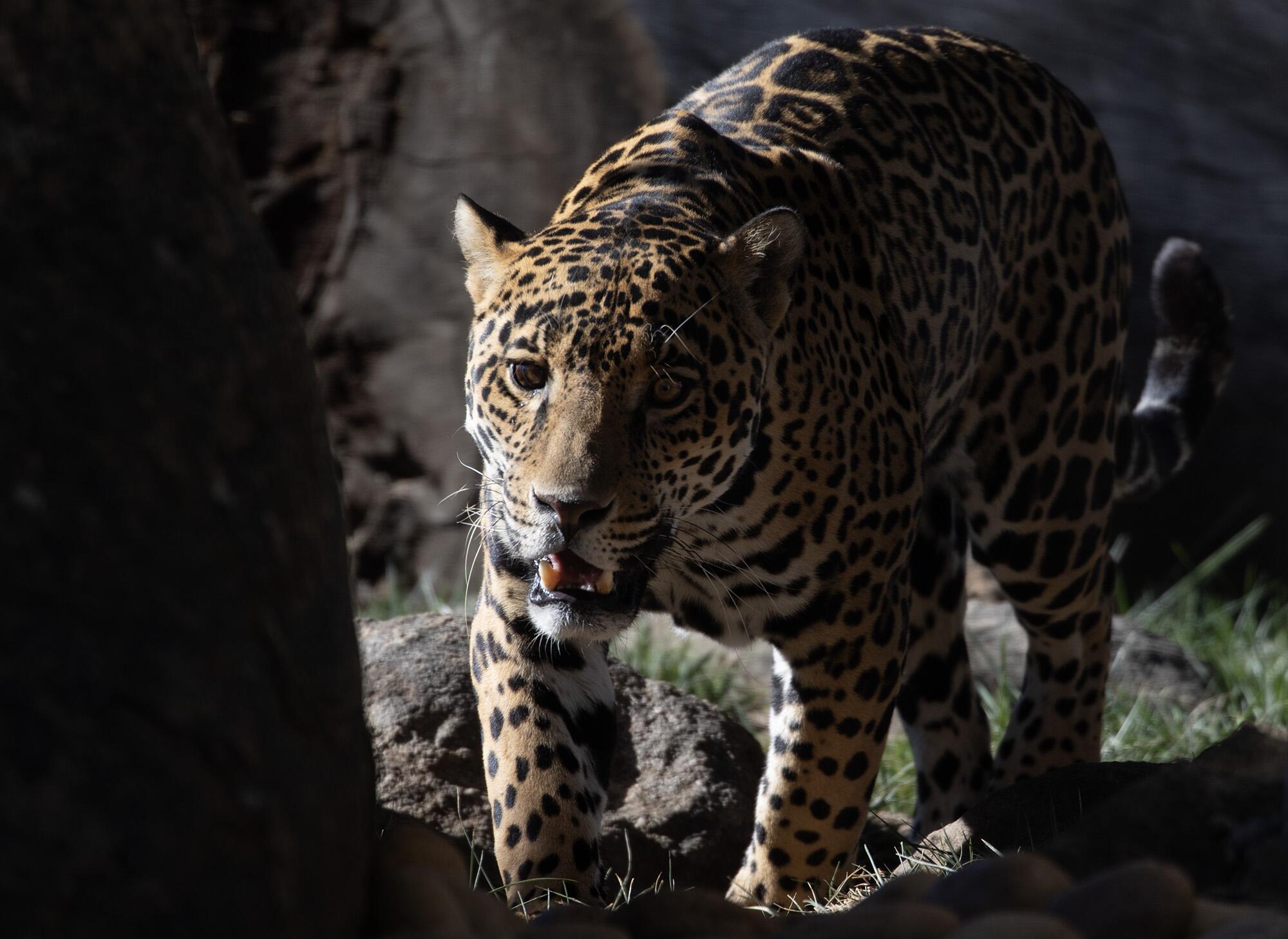
The 118-pound jaguar known as Eddie gazed down from the perch where he lounged on a recent Thursday morning at the Lions Tigers & Bears Sanctuary.
As a tour group moved past the six-gauge steel fence that surrounds his enclosure, Eddie followed along. He stealthily navigated his habitat, which cost around $225,000 to build and features grass, rocks, climbing platforms and a pool the jaguar likes to dip in.
The tour guide, Karen Schon, a sanctuary volunteer, told the group how Eddie had been used for photo shoots. How there had been plans to kill him. How he’d been abandoned at the sanctuary three years ago.
“That is how we got our first and only jaguar,” Schon said.
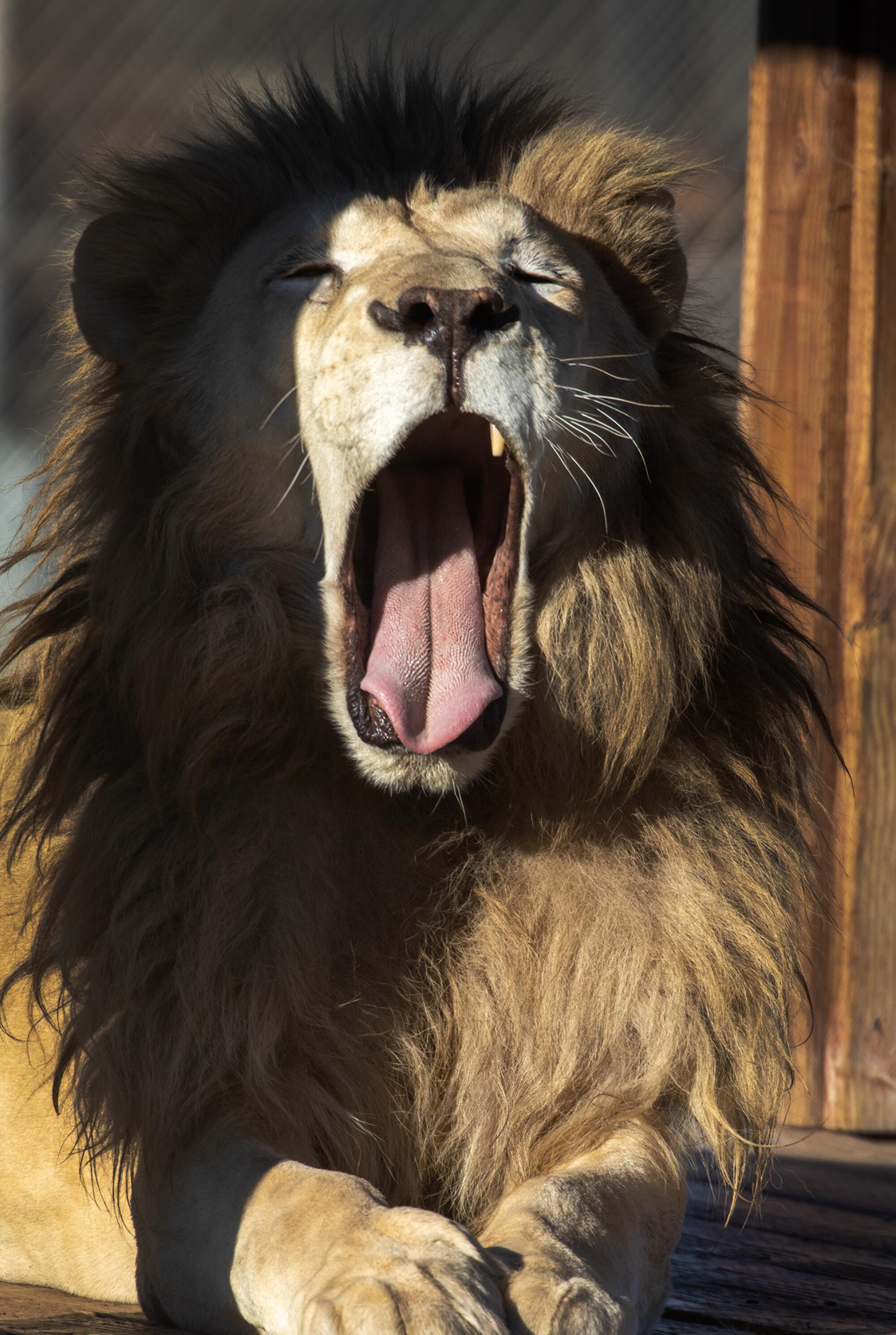
Eddie’s closest neighbors include Rocky, a grizzly bear that once worked in the film industry, and Louie, a retired entertainment industry lion whose roar occasionally rends the air. They are some of the more than 60 rescued animals that live on the 142-acre property.
Other notable sanctuary residents are Jem and Zoe — featured on the “Tiger King” — and Meatball, the infamous bear who lumbered through neighborhoods, swimming in pools, opening a refrigerator and consuming Costco meatballs.
“It’s their forever home,” said John Schorman, a sanctuary keeper. “It’s a privilege watching all the animals thrive.”
The nonprofit sanctuary, which relies on donations, has seen a slowdown recently in paying visitors. Brink estimated it costs $20,000 a year just to feed Eddie, who consumes six pounds or so of raw meat on feeding days. (Beef ribs are his favorite).
Brink doesn’t mince words when she talks about those who try to keep animals such as Eddie as pets, calling it “selfish.”
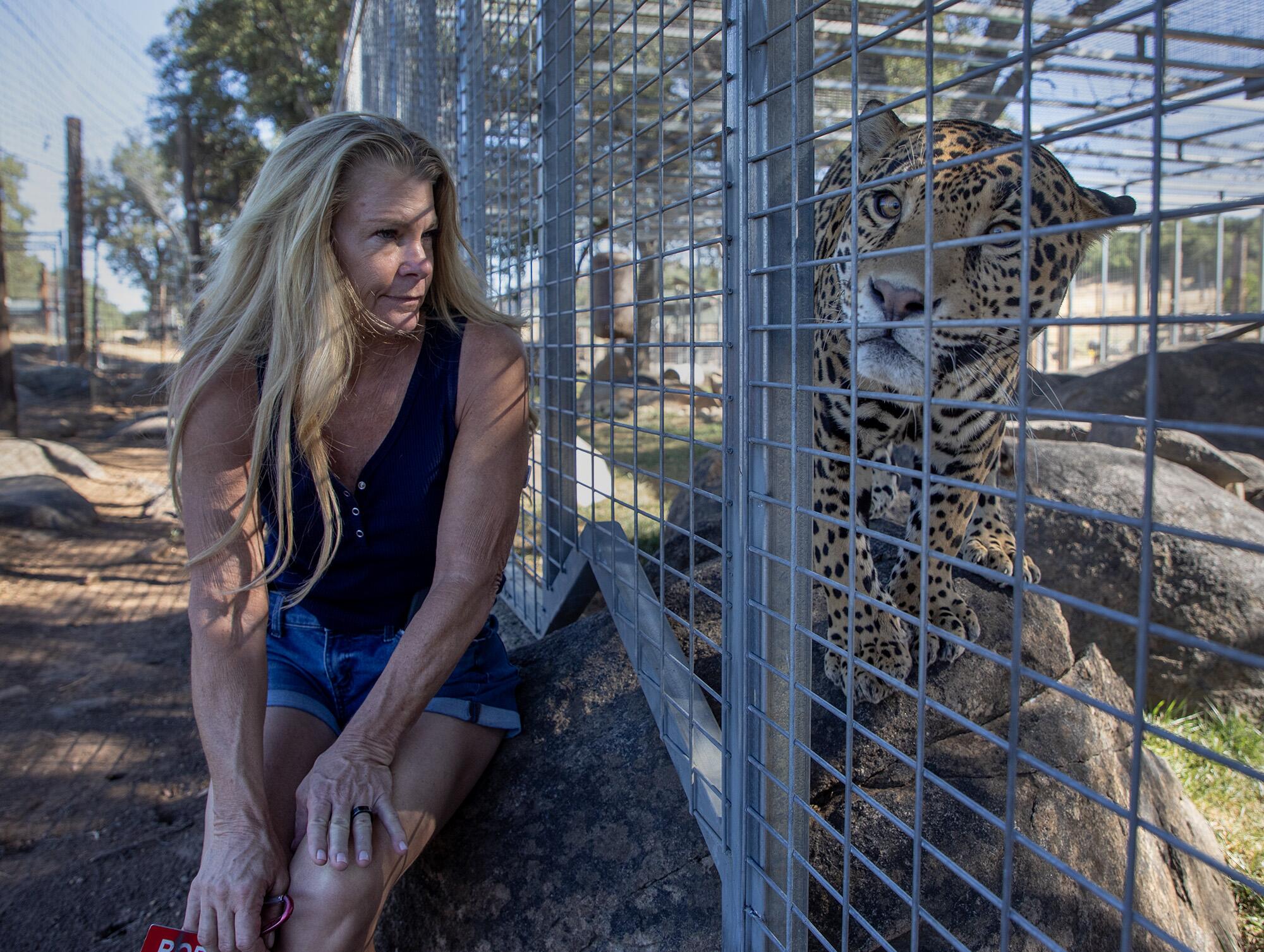
Such people ruin animals’ lives, “because they’re meant to be wild,” Brink said. “They’re not meant to be in a cage.”
More to Read
Sign up for This Evening's Big Stories
Catch up on the day with the 7 biggest L.A. Times stories in your inbox every weekday evening.
You may occasionally receive promotional content from the Los Angeles Times.

